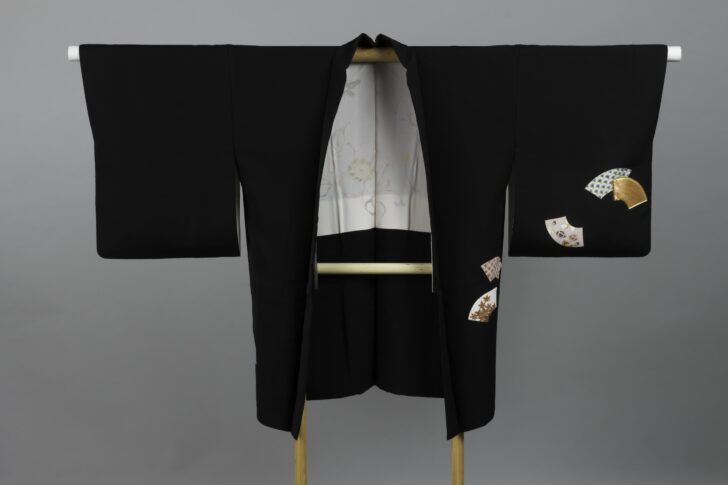Haori
Japanese

Description
Subject Matter:
The folding fan motifs design include gold patchwork, lotus, autumnal foliage, floral, clouds, plum blossoms, peonies, bamboo, various geometric patterns, interlocking circles motif with flowers, modified sauvastika (reverse swastika) motif patternings called “sayagata” in Japanese, seigaiha (crest wave) motifs, and bishamon hexagon motifs that resemble tortoise shells. The word “Bishamon” derives from describing the hexagonal pattern found on the guardian deity Bishamon’s armor.
Chirimen refers to the unique wrinkled texture, also called crepe texture, created by a specific weaving technique. This texture is often used with traditional Japanese fabrics, often silk, wool, or synthetic fiber.
The Haori is a traditional Japanese hip or thigh-length jacket with elongated sleeves that is worn over the kimono. The Haori typically includes an interior lining with a design that is otherwise hidden from view when worn.The haori was originally part of a man’s formal attire, but in the nineteenth century, female entertainers in Edo (modern Tokyo) adopted it as a cloak for outdoor wear in mild weather. By the end of the century, married women of the upper class adopted black crepe silk haori with family crests for formal, public occasions. For much of the twentieth century, the haori has been the standard outerwear for a woman who dresses in a kimono outside the home.
Physical Description:
Black formal chirimen haori with colorful dyed, patched, and interwoven folding fan motifs on the left front and back sleeves and on the lower back and front with a silk white inner lining with hand-painted pale floral designs. It has one family crest on the center on back.
Usage Rights:
If you are interested in using an image for a publication, please visit https://umma.umich.edu/request-image/ for more information and to fill out the online Image Rights and Reproductions Request Form.